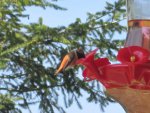Well got a visitor today, lost one fish, thought it was after a frog. But learned how the bird did the fishing.
A bitten came, raining nicely, it flew in, sat in the maple tree at the edge of the pond. Finally flew into the bog, investigated the chicken wire, it walked down to one area I don't have fenced, the pump area. I am changing out the pump and plumbing with my dragon pump so have not gotten around to putting up a good fence. Have it heron safe, I think, lol, but not bitten safe.
The little bitten walked around the fence, came through the small gap, and walked down the bog wall. It sat for a while on the bog waterfall rock, you could see it really wanted a fish, they were right below. The fish saw the bird and all went deep and to the middle of the pond. Then the bitten walked down to the skimmer area. I know a bunch of frogs hand out there, so we were watching, saw the frog jump into the pond, saw the bird tense, but it came up with a small goldfish. The fish must have been in the iris pots or right behind them. So now know what I need to do to stop this little guy. It can not fly in and land on the bog wall, it does need to walk in from the bog or yard, so need to close the gap, might even put the fencing over the bog wall instead of behind it. Can hardly see the fence with the plants that are growing.
The camera would not focus well for some reason, this video is the bitten fishing from the waterfall rock.
Here the bitten goes down the bog wall until it snags a small goldfish.
He sat in this tree in the back yard for quite a while thinking about the fish .........
From the net
Although common in much of its range, the American Bittern is usually well-hidden in bogs, marshes and wet meadows. Usually solitary, it walks stealthily among
cattails or
bulrushes. If it senses that it has been seen, the American Bittern becomes motionless, with its bill pointed upward, causing it to blend into the reeds. It is most active at dusk. More often heard than seen, this bittern has a call that resembles a congested pump.
This secretive bird inhabits areas of tall reeds and marshes, and it uses the defense of camoflauge to hide from intruders by imitating the coloration and movement of a reed. For this reason alone, American Bitterns are not easy wading birds to spot. You'll be more likely to hear one before seeing one, and if you catch a glimpse of this elusive heron, count yourself truly blessed!
This stocky heron is heavily streaked with tan, brown, and white over its entire body. Darker wings and flight feathers, a black face, and neck streaks accentuate the plumage. Males and females have similar plumage. The bittern has a 3 foot wingspan, and is approximately 2.5 feet long from the tip of its long pointed bill to the end of its tail. While the bird appears quite large, it weighs only about a pound.






